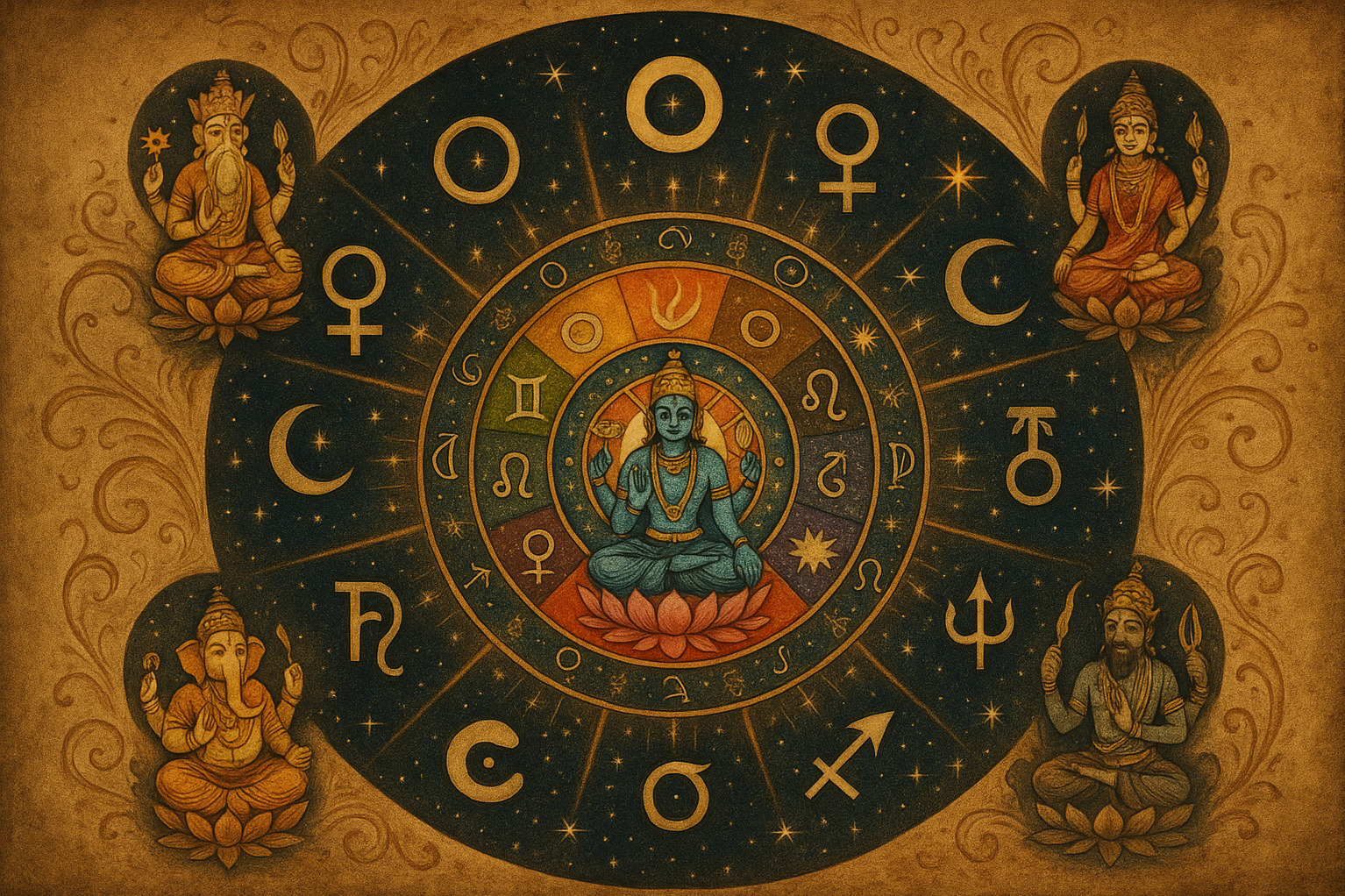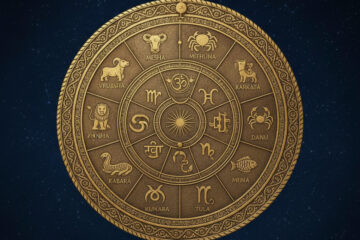The significations of zodiac signs in Vedic astrology go beyond elements and modalities. Each rāśi carries a bias of expression (male/female), a prevailing guna (sattva, rajas, tamas), and several classical attributes that affect temperament and timing. Read this as design, not dogma — a way energy prefers to move through a chart.
Understanding Sign Significations in Vedic Astrology
Think in layers. Elements describe temperament; modalities describe motion; gender shows the direction of expression; gunas reveal the weight of consciousness. When you combine these with lordship and dignity, the chart stops being a list and becomes a living architecture.
Sign Gender — Male and Female Expression
Male (odd) signs: Aries, Gemini, Leo, Libra, Sagittarius, Aquarius.
Female (even) signs: Taurus, Cancer, Virgo, Scorpio, Capricorn, Pisces.
Meaning: Male signs tend toward externalization — action, visibility, initiation, assertion. Imbalanced, they push or dominate. Female signs tend toward internalization — receptivity, protection, intuition, consolidation. Imbalanced, they can withdraw or over-nurture. This polarity is psychological and technical: it appears in compatibility work, certain child-gender judgments, and timing (masculine signs often show quicker external responses; feminine signs unfold through inner processes).
The Three Gunas — Sāttvik, Rājasik & Tāmasik
The guna layer describes the spiritual bias of a sign. It’s not morality; it’s momentum.
Sāttvik — Cancer, Leo, Sagittarius, Pisces
Bias toward clarity, faith, uplift, learning, altruism. Ruled by luminaries and Jupiter — planets that illuminate and orient. When centered, they refine desire; when uncentered, they preach and drift.
Rājasik — Taurus, Gemini, Virgo, Libra
Bias toward activity, expression, creation, commerce, society. Ruled by Mercury and Venus — speech, trade, taste, relationship. When balanced, they build civilization; when excessive, they inflate vanity and restlessness.
Tāmasik — Aries, Scorpio, Capricorn, Aquarius
Bias toward density, control, survival, transformation. Ruled by Mars and Saturn — force and form. Elevated, they give endurance, discipline and occult insight; afflicted, they harden into fear, cruelty or materialism.
Additional Classical Classifications
Violent Signs
Aries, Scorpio, Capricorn. Under affliction, they tend to direct destructiveness or coercive pressure. Well-placed, the same current becomes clean power: disciplined action, crisis leadership, structural courage.
Barren vs. Fruitful Signs
Barren: Aries, Gemini, Leo, Virgo — less conducive to biological fertility, often fertile in ideation (intellectual or creative “offspring”).
Fruitful: Cancer, Scorpio, Pisces — water signs that promote conception, growth and emotional abundance.
Usage: In fertility judgments, read these alongside the 5th house, its lord, Jupiter, Moon and the Saptamśa (D7). Outside fertility, “barren” can signal dryness in nourishment or affect display.
Shirṣodaya / Priṣṭodaya / Ubhayodaya
Shirṣodaya (rising head-first): Gemini, Leo, Virgo, Libra, Scorpio, Aquarius — planets here often show results in the first half of their daśā periods.
Priṣṭodaya (rising back-first): Aries, Taurus, Cancer, Sagittarius, Capricorn — results tend to gather in the latter half of daśās.
Ubhayodaya: Pisces — mixed or mid-period results.
These are subtle but useful when you must choose between two plausible timings.
Putting It All Together — From Theory to Interpretation
Stack the layers: planet → sign → element → modality → gender → guna → dignity → lordship → aspects → divisionals → result.
Example: Aries blends masculine, fiery, movable qualities — rapid, outward, initiating. Pisces blends feminine, watery, dual and sāttvik qualities — receptive, adaptive, imaginal, spiritual. Add the planetary ruler (Mars for Aries, Jupiter for Pisces), check dignity and dispositors, and the signature becomes unmistakable.
Practice until recognition replaces memorization. When the pattern is embodied, synthesis becomes natural.
Important Notes & Clarifications
Why are Capricorn and Aquarius “Tāmasik” if Saturn signifies discipline and work?
Each lord and sign spans low to high expression. Saturn’s higher arc is discipline, patience, mastery; its lower arc is fear, inertia, scarcity fixation. “Tāmasik” here means bound to density, not laziness. These signs often teach detachment through pressure — turning weight into wisdom.
Why do some authors list different guna sets for the signs?
Streams differ: one derives gunas from planetary rulers, another from elemental patterns. This guide prefers the planetary logic (Mars/Saturn → tāmasik; Mercury/Venus → rājasik; luminaries/Jupiter → sāttvik). Use one consistent scheme across charts to avoid mixed signals.
Are “barren signs” only relevant for the 5th house?
Primarily, yes — fertility analysis centers on the 5th, its lord, Jupiter and Moon (with D7). Still, the symbolism generalizes: “barren” can describe dryness in emotional nourishment or output style. Always corroborate across factors.
Why isn’t Aquarius listed as a violent sign though Saturn rules it?
In this context “violent” means direct, personal destructiveness (more Mars-like or Saturn under harsh pressure). Aquarius is Saturnian but airy — systemic, reformist, abstracted — so its pressure expresses through ideas and structures more than raw confrontation.
FAQ — Practical Application of Sign Attributes
How does sign gender matter beyond masculine/feminine traits?
It functions as polarity and pacing. Masculine signs externalize and quicken; feminine signs internalize and ripen. In compatibility, a balance of polarities stabilizes; excess of one side pushes toward conflict (too active) or passivity (too receptive).
How do the three gunas show up in behavior?
Sāttvik emphasizes clarity, faith, teaching, healing. Rājasik emphasizes achievement, commerce, relationship and movement. Tāmasik emphasizes endurance, control, survival and deep transformation. None is “bad”; imbalance is. Awareness harmonizes them.
How are Shirṣodaya/Priṣṭodaya/Ubhayodaya used in timing?
As a refinement inside daśā/bhukti windows. If two periods compete, prefer earlier results for planets in Shirṣodaya signs, later for Priṣṭodaya, and mid-window for Ubhayodaya (Pisces). Always cross-check with transits, dignities and divisionals.
Conclusion — The Physics of Expression
Every sign is a bias in how consciousness moves: outward or inward, light or heavy, fast or adaptive. When you read the significations of zodiac signs in Vedic astrology through gender, guna and classical attributes, patterns stop being superstition and become cause-and-effect. This is a grammar for karma — precise, testable, human.
Ask your karma. Decode your chart at Much Needed Astro.



